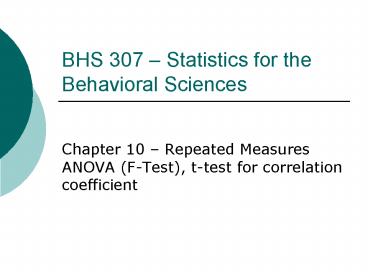BHS 307 Statistics for the Behavioral Sciences - PowerPoint PPT Presentation
1 / 22
Title:
BHS 307 Statistics for the Behavioral Sciences
Description:
Lower values of r become significant with greater sample sizes: ... A mixed ANOVA is performed using the Repeated Measures General Linear Model menu ... – PowerPoint PPT presentation
Number of Views:55
Avg rating:3.0/5.0
Title: BHS 307 Statistics for the Behavioral Sciences
1
BHS 307 Statistics for the Behavioral Sciences
- Chapter 10 Repeated Measures ANOVA (F-Test),
t-test for correlation coefficient
2
Population Correlation Coefficient
- Two correlated variables are similar to a matched
sample because in both cases, observations are
paired. - A population correlation coefficient rho (r)
would represent the mean of rs for all possible
pairs of samples. - Hypotheses
- H0 r 0
- H1 r ? 0
3
t-Test for Rho (r)
- Similar to a ttest for a single group.
- Tests whether the value of r is significantly
different than what might occur by chance. - Do the two variables vary together by accident or
due to an underlying relationship?
4
Formula for t-test of r
Aleks uses this
The Aleks formula is equivalent to the definition
formula
This is the predictive error
5
Calculating t for Correlated Variables
- Except that r is used in place of X, the formula
for calculating the t statistic is the same. - The standard error of prediction is used in the
denominator to calculate the standard deviation. - Compare against the critical value for t with df
n 2 (n pairs).
6
Importance of Sample Size
- Lower values of r become significant with greater
sample sizes - As n increases, the critical value of t
decreases, so it is easier to obtain a
significant result. - Cohens rule of thumb for r values
- .10 weak relationship
- .30 moderate relationship
- .50 strong relationship
7
Back to ANOVA Again
- Repeated Measures ANOVA
- Used with 2 or more paired samples
- Factorial ANOVA (Two-way)
- Use with 2 or more independent variables
- Both IVs are independent samples
- Mixed ANOVA
- A two-way ANOVA with both between-subjects and
repeated measures IVs
8
Repeated Measures ANOVA
- Repeated Measures ANOVA one-way ANOVA but the
same subjects are measured in each group. - Estimates of variability are no longer inflated
by random error due to individual differences. - A more powerful F-test
- A way to make the denominator smaller.
9
The Repeated Measures F-Ratio
- The numerator contains the MS for between-groups,
as for one-way ANOVA. - The denominator contains only the error variance
(noise), not the entire within-group variance. - Variance for individual subjects is subtracted
from the entire within-group variance, leaving
the error variance.
10
Splitting Up the Variance
11
Finding SSsubject
SSsubject is calculated using row totals for each
subject. SSerror is the amount remaining when
SSsubject is subtracted from SSwithin.
12
Calculating SSerror and MSerror
This is the same as for one-way ANOVA
13
Effect Size for Repeated Measures ANOVA
- The effect size for repeated measures is called
the partial squared curvilinear correlation. - It is called partial because the effects of
individual differences have been removed.
14
Comparison to One-Way ANOVA
- Other assumptions hold (e.g., normality, equal
variance), but sphericity is an added assumption. - Sphericity means data are uncorrelated.
- Counterbalancing may be needed.
- h2 is interpreted the same way as for one-way
ANOVA. - Post-hoc t-tests need to be for paired samples,
not independent groups.
15
Two-Way ANOVA (pg 334 in text)
- Two-way (two factor) ANOVA tests hypotheses
about two independent variables (factors). - Three null hypotheses are tested
- Main effect for first independent variable
- Main effect for second independent variable
- Test for an interaction between the two variables.
16
Two Factors Age and Sex
Main effect for Age
H0 myoung mold H1 H0 is false
Main effect for Sex
H0 mmale mfemale H1 H0 is false
17
What About Within the Cells?
Main effect for Age
H0 myoung mold H1 H0 is false
Main effect for Sex
H0 mmale mfemale H1 H0 is false
An interaction occurs when the pattern within the
cells is different depending on the level of the
IVs.
H0 There is no interaction H1 H0 is false
18
Interaction
- Two factors interact if the effects of one factor
on the dependent variable are not consistent for
all levels of a second factor. - Interactions provide important information about
the question at hand. - Interactions must be discussed in your
interpretation of your results because they
modify main effects.
19
Applet Demonstrating Two-Way ANOVA
- http//www.ruf.rice.edu/lane/stat_sim/two_way/ind
ex.html - Try this at home to understand what an
interaction looks like when graphed and in a data
table.
20
Simple Effects
- A simple effect is the comparison of groups for
each level of one IV, at a single level of the
other IV. - Example Young and old males.
- Example Young males and females.
- Calculation of the simple effect is the same as
doing a one-way ANOVA on just one column or row. - Use t-tests to follow up.
21
Assumptions
- Similar to those for one-way ANOVA
- Normal distribution, equal variances
- All cells should have equal sample sizes.
- Use Cohens guidelines for effect size (h2).
- Use t-tests for multiple comparisons within cells.
22
Mixed ANOVAs
- One variable is between subjects.
- One or more variables are within subjects (paired
or repeated measures). - A mixed ANOVA is performed using the Repeated
Measures General Linear Model menu choice on
SPSS. - Formulas are complex and beyond the scope of this
course.































